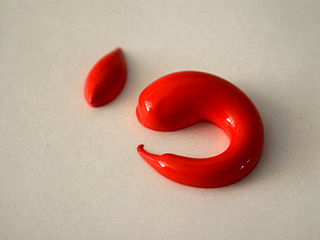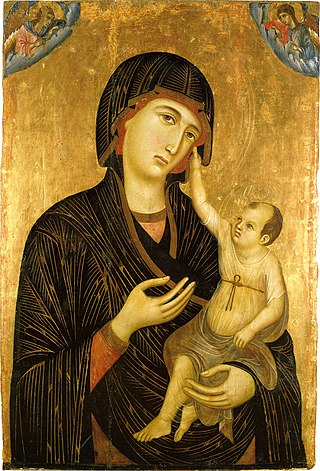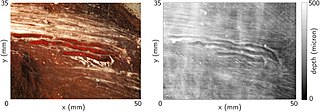
Acrylic paint is a fast-drying paint made of pigment suspended in acrylic polymer emulsion and plasticizers, silicone oils, defoamers, stabilizers, or metal soaps. Most acrylic paints are water-based, but become water-resistant when dry. Depending on how much the paint is diluted with water, or modified with acrylic gels, mediums, or pastes, the finished acrylic painting can resemble a watercolor, a gouache, or an oil painting, or have its own unique characteristics not attainable with other media.

Oil painting is the process of painting with pigments with a medium of drying oil as the binder. It has been the most common technique for artistic painting on wood panel or canvas for several centuries, spreading from Europe to the rest of the world. The advantages of oil for painting images include "greater flexibility, richer and denser colour, the use of layers, and a wider range from light to dark". But the process is slower, especially when one layer of paint needs to be allowed to dry before another is applied.

Paint is any pigmented liquid, liquefiable, or solid mastic composition that, after application to a substrate in a thin layer, converts to a solid film. It is most commonly used to protect, color and primer, or provide texture. Paint can be made in many colors—and in many different types. Paint is typically stored, sold, and applied as a liquid, but most types dry into a solid. Most paints are either oil-based or water-based and each has distinct characteristics. For one, it is illegal in most municipalities to discard oil-based paint down household drains or sewers. Clean-up solvents are also different for water-based paint than they are for oil-based paint. Water-based paints and oil-based paints will cure differently based on the outside ambient temperature of the object being painted. Usually, the object being painted must be over 10 °C (50 °F), although some manufacturers of external paints/primers claim they can be applied when temperatures are as low as 2 °C (35 °F).

A pastel is an art medium in a variety of forms including a stick, a square, a pebble, or a pan of color, though other forms are possible; they consist of powdered pigment and a binder. The pigments used in pastels are similar to those used to produce some other colored visual arts media, such as oil paints; the binder is of a neutral hue and low saturation. The color effect of pastels is closer to the natural dry pigments than that of any other process. Pastels have been used by artists since the Renaissance, and gained considerable popularity in the 18th century, when a number of notable artists made pastel their primary medium.

Tempera, also known as egg tempera, is a permanent, fast-drying painting medium consisting of colored pigments mixed with a water-soluble binder medium, usually glutinous material such as egg yolk. Tempera also refers to the paintings done in this medium. Tempera paintings are very long-lasting, and examples from the first century AD still exist. Egg tempera was a primary method of painting until after 1500 when it was superseded by oil painting. A paint consisting of pigment and binder commonly used in the United States as poster paint is also often referred to as "tempera paint", although the binders in this paint are different from traditional tempera paint.

Canvas is an extremely durable plain-woven fabric used for making sails, tents, marquees, backpacks, shelters, as a support for oil painting and for other items for which sturdiness is required, as well as in such fashion objects as handbags, electronic device cases, and shoes. It is popularly used by artists as a painting surface, typically stretched across a wooden frame.

Watercolor or watercolour, also aquarelle, is a painting method in which the paints are made of pigments suspended in a water-based solution. Watercolor refers to both the medium and the resulting artwork. Aquarelles painted with water-soluble colored ink instead of modern water colors are called aquarellum atramento by experts. However, this term has now tended to pass out of use.

Umber is a natural earth pigment consisting of iron oxide and manganese oxide; it has a brownish color that can vary between shades of yellow, red, and green. Umber is considered one of the oldest pigments known to humans, first seen in Ajanta Caves in 200 BC-600 AD. Umber's advantages are its highly versatile color, warm tone, and quick drying abilities. While some sources indicate that umber's name comes from its geographic origin in Umbria, other scholars suggest that it derives from the Latin word umbra, which means "shadow." The belief that its name derives from the word for shadow is fitting, as the color helps create shadows. In addition, the color is primarily imported from Turkey, specifically Cyprus, and not Italy. Umber is typically mined from open pits or underground mines and ground into a fine powder that is washed to remove impurities. In the 20th century, the rise of synthetic dyes decreased the demand for natural pigments such as umber.

Grey or gray is an intermediate color between black and white. It is a neutral or achromatic color, meaning literally that it is "without color", because it can be composed of black and white. It is the color of a cloud-covered sky, of ash and of lead.
In art, an underpainting is an initial layer of paint applied to a ground, which serves as a base for subsequent layers of paint. Underpaintings are often monochromatic and help to define color values for later painting. Underpainting gets its name because it is painting that is intended to be painted over in a system of working in layers.

In painting, a pentimento is "the presence or emergence of earlier images, forms, or strokes that have been changed and painted over".

A panel painting is a painting made on a flat panel of wood, either a single piece or a number of pieces joined together. Until canvas became the more popular support medium in the 16th century, panel painting was the normal method, when not painting directly onto a wall (fresco) or on vellum. Wood panels were also used for mounting vellum paintings.

Sinopia is a dark reddish-brown natural earth pigment, whose reddish colour comes from hematite, a dehydrated form of iron oxide. It was widely used in Classical Antiquity and the Middle Ages for painting, and during the Renaissance it was often used on the rough initial layer of plaster for the underdrawing for a fresco. The word came to be used both for the pigment and for the preparatory drawing itself, which may be revealed when a fresco is stripped from its wall for transfer.
A glaze is a thin transparent or semi-transparent layer on a painting which modifies the appearance of the underlying paint layer. Glazes can change the chroma, value, hue and texture of a surface. Glazes consist of a great amount of binding medium in relation to a very small amount of pigment. Drying time will depend on the amount and type of paint medium used in the glaze. The medium, base, or vehicle is the mixture to which the dry pigment is added. Different media can increase or decrease the rate at which oil paints dry.
Working in layers is a system for creating artistic paintings that involve the use of more than one layer of paint.

Underdrawing is a preparatory drawing done on a painting ground before paint is applied, for example, an imprimatura or an underpainting. Underdrawing was used extensively by 15th century painters like Jan van Eyck and Rogier van der Weyden. These artists "underdrew" with a brush, using hatching strokes for shading, using water-based black paint, before underpainting and overpainting with oils. Cennino D'Andrea Cennini describes a different type of underdrawing, made with graded tones rather than hatching, for egg tempera.
Historic paint analysis, or architectural paint research, is the scientific analysis of a broad range of architectural finishes, and is primarily used to determine the color and behavior of surface finishes at any given point in time. This helps us to understand the building's structural history and how its appearance has changed over time.

Self-Portrait with Beret and Turned-Up Collar is a 1659 oil on canvas painting by the Dutch artist Rembrandt, one of over 40 self-portraits by Rembrandt. It has been noted as a self-portrayal of subtle and somber qualities, a work in which may be seen "the stresses and strains of a life compounded of creative triumphs and personal and financial reverses". Once owned by Andrew W. Mellon, it has been in the National Gallery of Art since 1937.

A paintings conservator is an individual responsible for protecting cultural heritage in the form of painted works of art. These individuals are most often under the employ of museums, conservation centers, or other cultural institutions. They oversee the physical care of collections, and are trained in chemistry and practical application of techniques for repairing and restoring paintings.

In visual arts, the ground is a prepared surface that covers the support of the picture and underlies the actual painting. Occasionally the term is also used in a broad sense to designate any surface used for painting, for example, paper for watercolor or plaster for fresco.
















